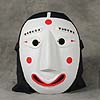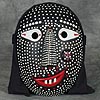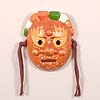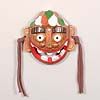Tal-nori The Korean Mask Performance
Origins
The Korean mask play, or Tal-nori, originated in Korea in Ha-hoe ri (Ha-hoe village), near An-dong shi (An-dong city), in Kyong-sang-buk-do (Kyong-sang North Province) in the 12th century which was right about the middle of the Koryo Dynasty. Legend has it that a man living in Ha-hoe village, was contacted by the gods and told to make 12 masks all the while avoiding contact with other humans or suffer dire consequences. He subsequently locked himself up in his house and began the task. But as he was nearing completion, a curious girl - who was quite fond of the man - spied on him through a hole in the wall of his house causing him to be punished by the gods with fatal results. At the time of his death, he had finished eleven of the twelve masks, and all but the chin of the last one - the Imae mask. To this day, the Imae mask is the only mask without a chin. While an entertaining story, the masks were more likely created by local villagers who wished to perform plays, which grew in popularity during that era, and have now come to be national treasures.
Meaning
While many, even in Korea, mistakenly think the word Tal means mask, it
actually is the Chinese character for, to rid oneself, or free oneself from
something - Korea adopted Chinese characters prior to the invention of their
own, unique alphabet under King Se-jong (1397-1450), and still use Chinese
characters extensively. Thereby, the original meaning of the Tal-nori (Tal play),
or Tal-chum (Tal dance), is a play or dance helps shed ones stress and
grief. During the Koryo Dynasty there was a considerable amount of social
tension and the lower classes found a way to relieve not only their everyday
stresses, but the tensions which existed between the many social classes in
Korea, through the Tal-nori. The plays often satirized upper classes of
society by portraying the Yang-ban, or aristocrats, with deformed faces,
or Jung, monks, as being depraved, or even themselves, the commoners who
performed the plays, as bumbling fools. There are many different regional names
for Tal-nori throughout Korea, in Song-pa it is called the San-dae
nori, in Yang-ju it is called Byeol-san-dae-nori, in Kang-ryong
it is called Tal-chum, etc. but by far, that which originated in Ha-hoe
village
- the Ha-hoe Pyolshin-gut T'al-nori, is the most famous. Though many
regions share some of the same characters in their versions of Tal-nori masks,
they often differ in appearance. Below are some of the regions and
representative styles of mask from those areas:
Song-pa |
Yang-ju |
Kang-ryong |
Dong-rae |
 |
 |
 |
 |
Wae-jang-nyo
|
Mi-yal-hal-mi
|
Chui-bal-i
|
Mal-dduk-i
|
Performance
Originally the Tal-nori was performed at
night, often in a clearing around a fire and the exaggerated colors and
expressions on some of the masks reflect a time when such vibrant colors and
expressions were necessary to make them visible in the poor light. Performances
were sometimes conducted on a slight hill so that the spectators below could see
the performers, and the audience often joined in the performance by taunting or
interacting with the performers' characters. All the performers in Tal-nori were
men including the female characters. Tal-nori is accompanied by Nong-ak,
or farmer's music, and was performed by four musicians on two types of gongs
and two types of drums. Tal-nori was generally performed in a series
of acts sometimes related and other times not, but some common themes from the
acts are the satirical portrayal of the upper classes, and the conflict between
an old or ugly wife and a young concubine. Traditionally, the performances had
no set schedule and could last for just a few hours, to all night, but in modern
times, they have become more structured and only last an hour or two.
Korean-Arts' masks
All Korean-Arts' masks, and other wood figurines, are hand-carved by Korean artisans using alder wood imported from the United States. The five-step process in their production includes; cutting large pieces of wood into the proper shaped blanks, after which they are hand-carved into their final shape by artisans. Next they are treated in a submersion bath to preserve the wood, dried and varnished. Lastly, the details are hand-painted on. We are proud that the folks that create our masks and wood figurines are some of the finest artisans in Korea, whose modern workshops fully support equal opportunity hiring and handicapped workers.